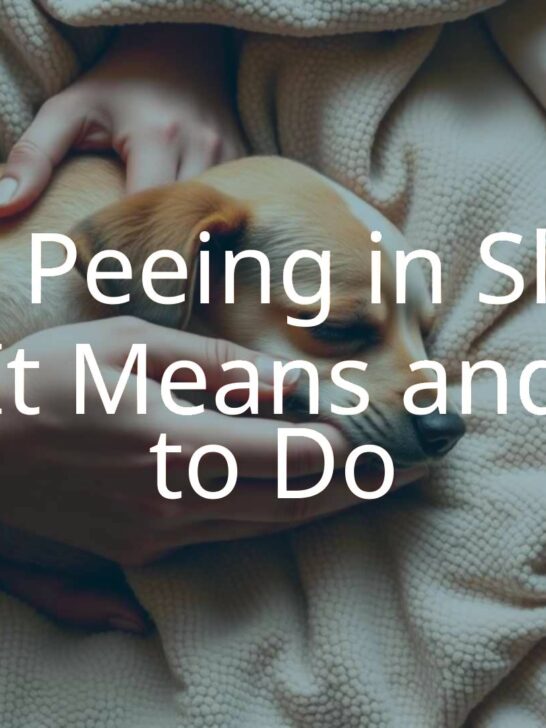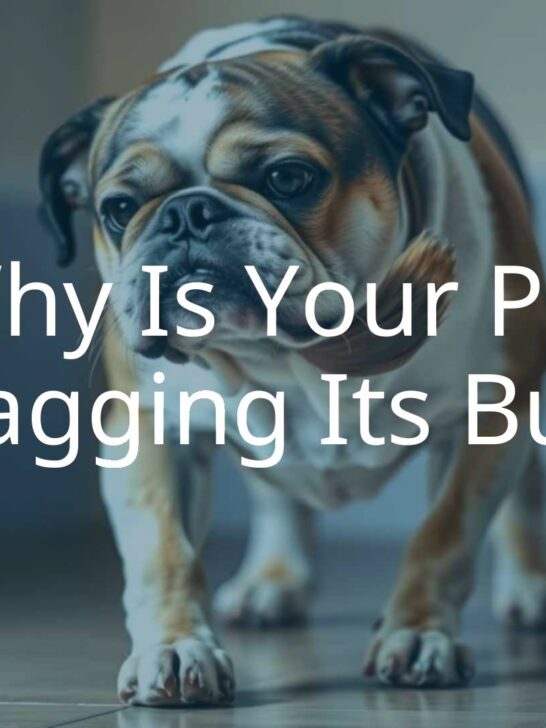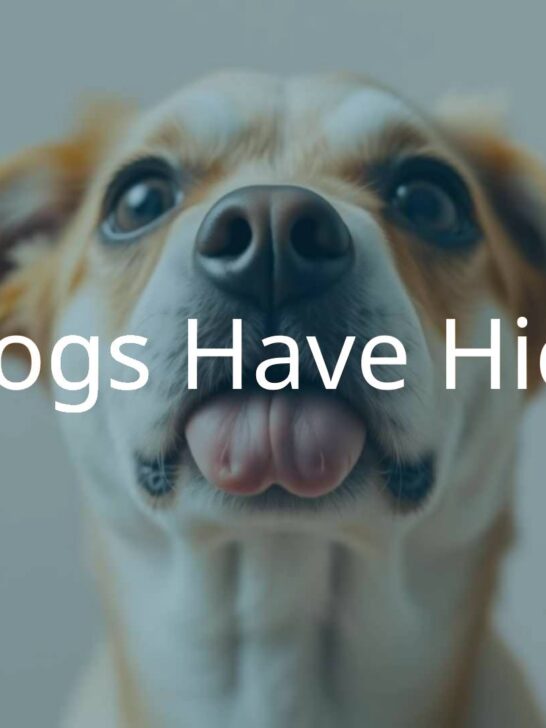Your Compelete Guide To Identifying Parvo Poop & Other Signs Of Parvovirus
If you’ve heard the term “parvo poop,” it means the unusual stool seen in dogs suffering from canine parvovirus. Parvo is a very contagious and serious illness that mainly attacks a dog’s digestive system and immune cells. The changes in a dog’s stool-such as its look, texture, and smell-are some of the first and most noticeable signs of this disease. Spotting these changes early and acting quickly by getting veterinary help can save a dog’s life.
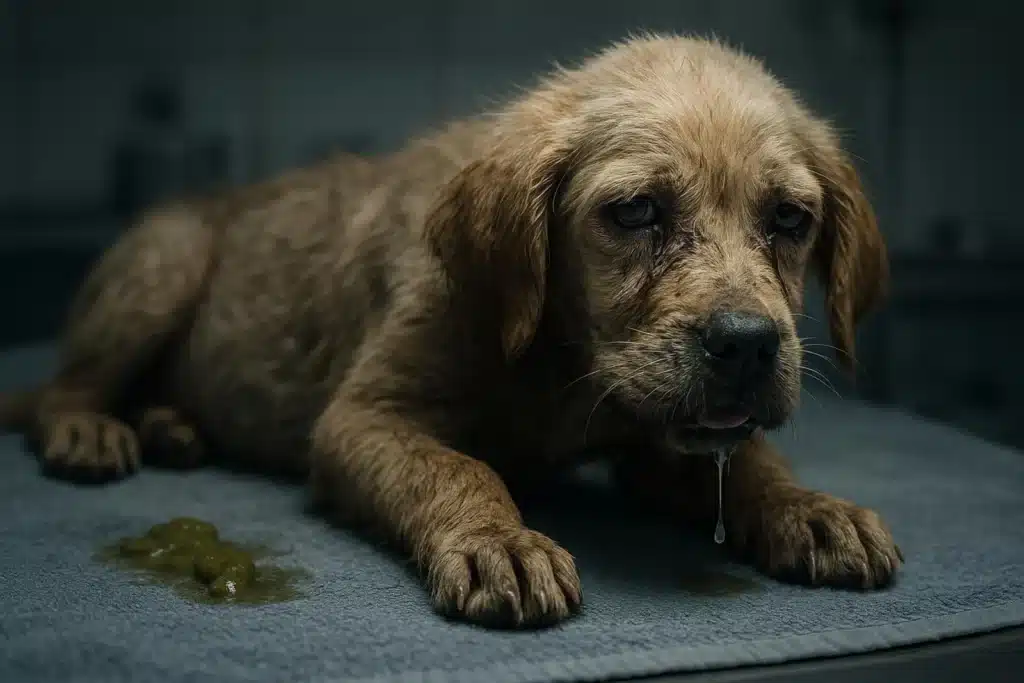
Canine parvovirus (CPV-2) spreads quickly and can cause severe symptoms. Although CPV-2 has a few different forms, they all give similar signs, so knowing the appearance of parvo poop is very important for dog owners. The virus can hurt the digestive tract and, in young puppies, even damage the heart, making it even more important to know what to look for.
What Is Parvo Poop?
Parvo poop describes the specific diarrhea produced by dogs infected with parvovirus. This happens because the virus destroys cells lining the intestines, leading to inflammation, poor absorption, and severe gut issues. Parvo poop usually stands out due to its look and smell, which often make dog owners seek emergency vet care.
It’s important to know that “parvo poop” is just one part of how parvo shows up in a sick dog. Other signs like tiredness, not eating, vomiting, and stomach pain usually happen as well. All these symptoms together are a strong warning that the dog has a serious infection and needs help right away.
How Does Parvovirus Infection Change a Dog’s Stool?
Parvovirus attacks the lining of the small intestine, which is needed for absorbing food and fluids and keeping bacteria out of the bloodstream. When this lining is harmed, it can’t work properly, leading to severe diarrhea. The weaker gut wall can also allow bacteria into the bloodstream, which can be life threatening. This damage adds to the odd color, extra water, and strong smell in parvo poop.
Which Dogs Are Most at Risk for Parvo Poop?
All dogs can get parvovirus, but puppies are at the highest risk, especially those between 6 and 20 weeks old. At this stage, their mother’s immune protection fades before their own vaccinations are finished, so they can be left unprotected. Any dog who is not fully vaccinated, no matter its age, is in danger. Some breeds, like Rottweilers, Dobermans, Bull Terriers, German Shepherds, and English Springer Spaniels, seem to catch the virus more easily. Owners of puppies and these breeds should be especially watchful for signs of parvo, including changes in stool.

What Does Parvo Poop Look Like?
Parvo poop is very different from normal dog stool, mainly because of its color, texture, smell, and the number of times it happens. Noticing these signs as soon as possible is the best way to catch parvo early and give the dog a real chance at recovery.
The diarrhea caused by parvo is due to the heavy damage in the gut, making it hard for the dog to absorb food or water.
Color Changes in Parvo Poop
One thing many owners notice first is the color. Parvo poop can be very dark brown or almost black, which usually means there’s blood that’s been digested because of internal bleeding in the gut. Sometimes, the stool might look reddish, showing there is fresh blood. Both are warning signs and show serious injury to the intestines.
Texture and Consistency
Parvo poop is typically very watery-more so than regular diarrhea-and may also contain mucus, giving it a slippery look. This is because the ruined intestine can’t absorb water or stop it from leaking out. This leads to dehydration very quickly.
Distinctive Odor
The smell of parvo poop is extremely strong and rotten-often described as metallic or like rotting flesh. This happens because the sick gut can’t control the normal bacteria, which leads to an overgrowth and abnormal fermentation. This smell is hard to miss and can sometimes be noticed from a distance.
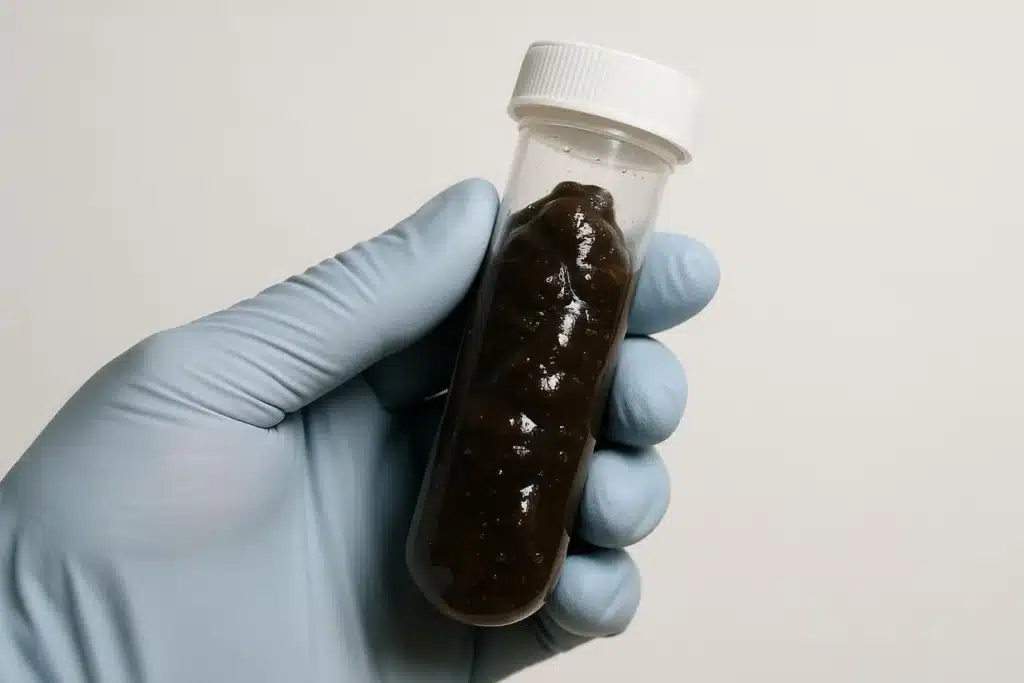
Frequency of Defecation
Dogs with parvo don’t just go more often-their diarrhea is urgent and hard to control, with many episodes per day. This constant fluid loss is dangerous and speeds up dehydration, which is why action must be taken quickly.
Comparison Table: Normal Dog Poop vs. Parvo Poop
| Feature | Normal Dog Stool | Parvo Poop |
|---|---|---|
| Color | Chocolate brown | Dark brown/black or red |
| Consistency | Firm, easy to clean up | Watery, liquid, hard to pick up |
| Odor | Mild | Very foul, metallic, rotten |
| Frequency | Regular, once or twice a day | Many times per day, often urgent |
How Is Parvo Poop Different From Other Diarrhea?
Many things cause diarrhea in dogs, but parvo poop has key signs: it is more watery, smells much worse, is often bloody, and comes with other signs like vomiting, tiredness, and not eating. Normal diarrhea from diet changes or minor bugs is less severe and doesn’t cause dogs to get worse as quickly, or show blood as commonly. Knowing how parvo is different helps you decide if it’s time to call the vet right away.
Key Symptoms to Look For
- Very watery diarrhea, often with lots of mucus
- Blood in the stool (dark, black, or red)
- Very bad smell
- Vomiting
- Lethargy and loss of appetite
Other Warning Signs
- Repeated vomiting, sometimes before diarrhea starts
- Extreme tiredness
- Pain or swelling in the belly
- High or low body temperature
- Quick worsening of symptoms
When these show up with parvo poop, especially in a puppy or unvaccinated animal, get your pet to the vet immediately.
When Does Parvo Poop Start After Exposure?
Parvo moves quickly. From exposure, most dogs start showing symptoms between three and seven days. Vomiting often starts first, with diarrhea showing up soon after. Both can cause dehydration and shock rapidly, so early vet care is needed.
A dog can start passing the virus in its stool even before there are any obvious signs. This shedding continues for about two weeks after the dog seems better. This is why strict hygiene is needed even after the dog finishes treatment.
Parvo Timeline Table
| Stage | Timeframe | Events |
|---|---|---|
| Incubation | 3-7 days after exposure | No signs yet, but virus is multiplying |
| Early signs | After incubation | Vomiting, then diarrhea (parvo poop) |
| Severe illness | Within 1-2 days after early signs | Lots of diarrhea, dehydration, other symptoms |
| Recovery/virus shedding | Up to 2 weeks after symptoms end | Dog still contagious through stool |
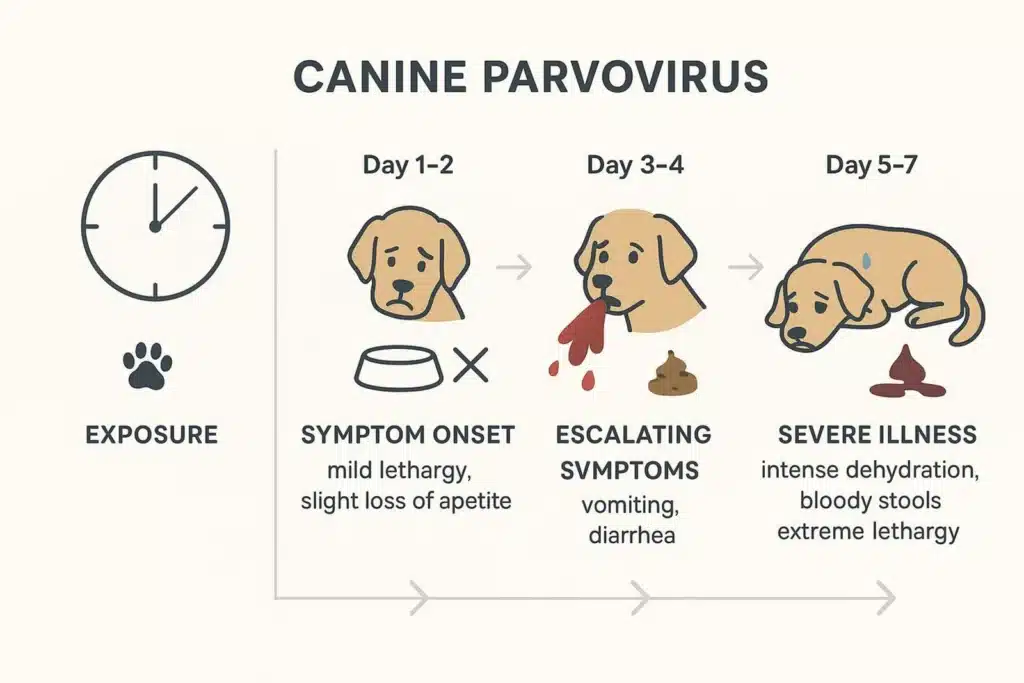
What Should You Do if You See Parvo Poop?
Finding parvo poop means your dog is very sick and needs help right away. The sooner you act, the better the chance of survival. Waiting or trying to treat your dog without a vet can be deadly.
Immediate Actions
- Keep the sick dog away from all other animals in your house.
- Choose an area for the sick dog that’s easy to clean.
- Do not touch other dogs after handling the sick one until you’ve washed up and changed clothes.
- Call your vet right away, describe what you’re seeing, and follow their advice.
- Don’t try to treat parvo at home-only a vet can provide the right care.
When to See a Vet
- No matter what, contact your vet as soon as you notice watery, bloody diarrhea-especially in puppies or unvaccinated dogs.
- Also call if you notice vomiting, tiredness, fever, or refusal to eat.
- Don’t wait for other symptoms or hope it goes away on its own-parvo is a medical emergency.
Mistakes to Avoid
- Don’t delay getting vet care. Time is extremely important.
- Don’t use home remedies or over-the-counter meds; they will not cure parvo.
- Don’t skip proper isolation of the sick dog-other pets could get infected fast.
- Don’t overlook cleaning-parvovirus can survive for months if you don’t use the right disinfectant.
How Do Vets Diagnose Parvo Poop?
Even if parvo is likely based on symptoms (like parvo poop), your vet will confirm with tests. This is important because other illnesses can look similar. The vet will act quickly, since time matters for treatment.
Common Tests
- Fecal SNAP ELISA (Parvo SNAP Test): A quick swab from your dog’s stool is tested in the clinic and results are ready in about 10 minutes.
- White Blood Cell Count: A blood test may show low white blood cells, which is often found in dogs with parvo.
- Lab Tests: For more information or if the diagnosis is unclear, samples may go to a lab for further testing.
What Happens When Your Vet Tests for Parvo?
- The vet or assistant collects a stool sample, often with a swab.
- The test is run right away. It works a bit like a rapid COVID or pregnancy test.
- You’ll get results in minutes. During this time, your vet checks your dog and talks through the next steps.
- If positive, your vet will explain treatment plans and start supportive care immediately.
How Long Is Parvo Poop Infectious?
Parvovirus lasts a long time in the environment, much longer than most viruses. This makes cleaning up and disinfecting very important to stop it from spreading to other dogs.
How Long Does Parvovirus Last in the Environment?
- The virus in dog poop or on surfaces stays infectious for months and sometimes longer than a year.
- It survives sunlight, heat, cold, and drying. It takes a strong bleach solution to kill it.
- Even tiny, unseen amounts of poop can have enough virus to infect another dog.
Safe Cleaning Tips
- Wear disposable gloves and old clothes when cleaning up any “parvo” mess.
- Remove all solid matter carefully and throw it in the trash.
- Disinfect hard surfaces and objects (like floors, food bowls, and crates) with a 1:30 bleach solution (3/4 cup bleach per gallon of water), leaving it on for at least 10 minutes before rinsing.
- Porous surfaces (like carpets, grass, and yards) are much harder to clean. Keep other dogs out of these areas for several months if possible.
- Repeat cleaning often, especially if you have more than one dog.
Can Parvo Poop Infect Other Dogs, Pets, or People?
Parvo is very contagious among dogs, and the virus spreads mostly through contact with stool from an infected dog. Understanding how it spreads helps keep other pets safe, but parvo does not infect people.
How the Virus Spreads
- The virus is mainly spread when a dog licks or eats something contaminated by infected stool.
- Other ways to spread the virus include kennels, food and water bowls, leashes, and even shoes or hands that picked up the poop.
- The virus can stick to shoes, fur, and objects for months, so indirect contact is also risky.
Can People or Other Animals Get Sick from Parvo?
- Parvo in dogs does not infect people-humans cannot catch this type of virus.
- Humans can still move the virus between areas on shoes, hands, or clothes, so good hygiene is important.
- Cats have their own type of parvovirus (feline distemper), which is different from the dog version.
- Other wild animals related to dogs, like coyotes and foxes, can also get parvo, but your cat at home is not at risk from canine parvo.
How Can Parvo and Parvo Poop Be Prevented?
The best way to avoid parvo is to prevent it in the first place, using three steps: vaccination, good hygiene, and proper isolation when needed. These steps are important for both puppies and adult dogs.
Vaccination
- Puppies should start the parvo vaccine series between 6-8 weeks old, with boosters every 2-4 weeks until at least 16 weeks.
- Older dogs who have never been vaccinated need two shots 2-4 weeks apart, then a one-year booster, and then boosters every three years.
- The vaccine does not give 100% protection, but it makes infection much less likely and milder if it does happen.
Hygiene and Isolation
- Keep sick dogs away from others right away.
- Clean with the bleach solution described above-most cleaners don’t kill parvo.
- Don’t take unvaccinated puppies to parks or kennels until their vaccines are done.
- Pick up and throw away your dog’s poop quickly.
- If you visit a place with known parvo, change your clothes and wash your hands before seeing other dogs.
Recovery Care
- Keep disinfecting the environment even after your dog is better, as the virus sticks around.
- Feed your recovering dog bland food to help heal the gut.
- Check that all other dogs in your home are up to date on their vaccines, especially before bringing in a new puppy.
Frequently Asked Questions About Parvo Poop
Can Adult Dogs Get Parvo?
Yes. Even though puppies are the most at risk, adult dogs who are not fully vaccinated can get parvo and become very sick. It’s important to keep vaccines current for dogs of all ages.
Is It Safe to Clean Parvo Poop at Home?
You can safely clean up if you use proper protection-gloves, old clothes, and a bleach solution. Be sure to throw away waste properly and clean all surfaces thoroughly. Remember, the main risk is spreading the virus to other dogs, not to yourself.
How Do I Know If My Dog’s Diarrhea Is Parvo?
Watch for very watery, often bloody diarrhea with a strong metallic or rotten smell, along with vomiting, extreme tiredness, and no appetite. If you see this, especially in a puppy or unvaccinated dog, go to your vet immediately for tests and treatment. Getting help right away gives your dog the best chance to survive.















